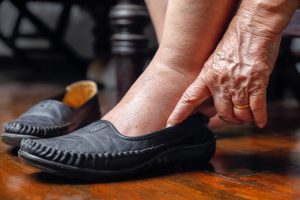Both fats and cholesterol belong to a wider group of chemical molecules called lipids. Lipids are one of the most important substances in our body with many different roles. There are three types of lipids:
- Triglyceride: commonly referred to as ‘fat’, is found in vegetable oil and fatty tissue in animals
- Phospholipid: the main component of cell membrane
- Steroid: plays important role in chemical signalling in animal and plant body. Some examples of steroids include cholesterol, testosterone, and androgen.
Our body maintains a delicate balance of lipids to sustain our daily activities. People with high fat and cholesterol levels have a higher risk of developing cardiovascular diseases: high blood pressure, stroke and coronary heart disease with potentially serious consequences.
Triglycerides (fats) and cholesterol
Lipids, including triglycerides and cholesterol, circulate in our blood. Our body uses fat as energy storage. It stores them in fat tissues, and releases them during exercise or period of hunger, to maintain our body’s minimal energy need.
On the other hand, cholesterol is utilised as building block for chemical hormones that regulate various processes. There are two types of cholesterol:
- High density lipoprotein (HDL), also sometimes known as ‘good cholesterol’
- Low density lipoprotein (LDL), also sometimes known as ‘bad cholesterol’.
LDL cholesterol is named ‘bad cholesterol’ as it joins fat in blood to form plaques on inner wall of arteries – a process known as atherosclerosis. On the other hand, HDL cholesterol takes up small cholesterol molecules and transports them back to the liver, thus lowering the chances of atherosclerosis. A simple blood test can determine your fat and cholesterol level as well.
Diseases related to high lipid levels
Hyperlipidaemia refers to a condition whereby the lipid levels in the blood are high. People with hyperlipidaemia are at a significant risk of developing cardiovascular diseases.
Hypertension and stroke
LDL cholesterol and triglycerides combine to form plaques on inner wall of the arteries, resulting in narrowed blood vessels. To maintain enough blood flow to tissues, blood will flow faster. This combined effect results in hypertension. Around 15-35% of Asian adult population has hypertension with many unaware of their own heart conditions
If the plaque inside the artery wall continues to grow bigger and blocks the vessel completely, the tissue supplied by that vessel will be deprived of blood and oxygen. Sometimes, small plaque can fall off the artery wall, travel in the blood stream and lodge onto smaller arterioles. A stroke is the result of poor blood flow to brain tissues which causes brain cell damage, with severe consequence of paralysis or death.
Mortality rate and stroke burden range from the lowest in Japan 43.3 per 100,000 person per year and Singapore (47.9), to the highest in Indonesia (193.3) and Mongolia (222.6). Multiple risk factors have contributed to the high mortality rate in Indonesia and Mongolia, including poorly funded health system, high fat & sugar diet and low socio-economic status.
People with known atherosclerosis should frequently monitor blood pressure and seek regular medical attention. Long term medical treatment and lifestyle modifications might be required as a result. Treatment of atherosclerosis-induced hypertension and stroke could be classified into two broad categories:
- Medical intervention
- Lifestyle modifications
Coronary heart disease (CHD)
If the plague forms inside the coronary arteries (i.e. the vessels that supply heart tissue), an angina or heart attack might happen. Under normal conditions, these blood vessels widen to increase blood supply to heart tissue during exercise and period of increased heart rate.
Angina is a type of chest pain caused by reduced blood flow to the heart. The plaque formation results in narrowed blood vessel. Thus during intense exercise, the heart does not receive enough blood and oxygen supply. Patients usually report severe chest pain that radiates to the left shoulder and the back. If you have the above symptoms, seek medical attention immediately.
If the plaque keeps growing in size and eventually blocks the blood vessels, a myocardial infarction might follow. This happens due to inadequate blood supply, leading to heart tissue death. The condition is commonly known as ‘heart attack’.
In Asia, the age-adjusted mortality rates of coronary heart disease varies by region. South Asian countries like India, Bangladesh and Pakistan have the highest rate – 220 per 100,000 person per year. East Asian countries like Japan, South Korea, and China have the lowest rate – 50 per 100,000 person per year.
Like hypertension and stroke, the underlying mechanism of coronary heart disease is very much alike. Thus, early medical intervention and lifestyle management is essential to prolong patient’s life and significantly reduce the chances of developing a heart attack.
Treatment for high lipid levels
Medical intervention
- Medications to lower blood cholesterol level: statins, bile acid resins, ezetimibe, niacin
- Medications to lower blood fat level: statins, fibrates
- Medication to prevent blood clot formation: aspirin
- Surgical intervention by angioplasty: placing a long thin tube (catheter) into the partially blocked blood vessel to place a small balloon at the site of the plaque. The balloon is inflated and the blood vessel should open to allow adequate flow of blood.
NOTE: Some medications should not be taken together. Inform your doctor the medications you are currently taking, including over-the-counter medication and supplements.
Lifestyle modification
- Frequent exercise to lose weight – our body fat is mostly composed of triglyceride. Exercise could significantly burn down body fat, thus reducing the chances of developing blood vessel plaque.
- Reduce fat intake – have a balanced diet and reduce the level of salt and sugar in your food
- Moderate amount of alcohol consumption – no more than 2 standard drinks (20 grams of alcohol) per day
- No smoking – smoking is a significant risk factor contributes to all heart diseases
- Reduce stress level – stress & mental pressure can unintentionally contribute to higher risk of developing heart diseases
Conclusion
Though the majority of people start to develop cardiovascular disease in their 60s, lipids such as triglycerides (fats) and cholesterol accumulate in our body over the decades. A plaque is formed over the years and can be difficult to detect, until blood supply has been compromised.
Many medical intervention alone often does not guarantee effectiveness and come with side effects. Lifestyle management to prevent high fat and cholesterol level from developing is of utmost importance.











